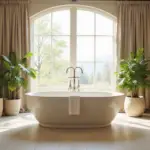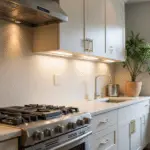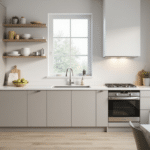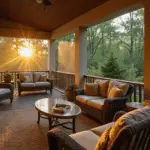Picture this: You’re standing in your dining room, envisioning the perfect gathering space for friends and family. At the heart of this vision is a stunning contemporary dining room table, a piece that not only serves as a functional centerpiece but also as a statement of your style. Did you know that choosing the right table can increase your home’s value by up to 20%? That’s right, folks – we’re not just talking about a place to eat; we’re talking about an investment in your home and your lifestyle.
As someone who’s spent years helping people create sustainable, beautiful living spaces, I can tell you that selecting the perfect contemporary dining room table is both an art and a science. It’s about balancing form and function, style and substance, and creating a harmonious space that reflects your unique personality. Whether you’re a minimalist maven or a lover of eclectic designs, there’s a table out there that’s just waiting to become the heart of your home.
In this guide, we’ll dive deep into the world of contemporary dining room tables, exploring everything from materials that will stand the test of time to shapes that maximize your space and sizes that fit your lifestyle. We’ll also take a look at how your table choice fits into the broader context of contemporary dining room design, ensuring that every element of your space works together in perfect harmony.

So, grab a cup of your favorite eco-friendly brew, and let’s embark on this journey to find your perfect contemporary dining room table. Trust me, by the end of this article, you’ll be itching to transform your dining space into the gathering spot of your dreams!
Key Takeaways
Before we dive in, let’s take a quick look at some key points to keep in mind:
- Sustainability is key: Choose materials that are not only durable but also environmentally friendly.
- Size matters: Your table should fit your space comfortably, allowing for easy movement and ample seating.
- Shape up: Consider how different table shapes can affect the flow and functionality of your dining area.
- Mix and match: Don’t be afraid to combine materials for a unique, personalized look.
- Think long-term: Invest in a table that will grow with your lifestyle and adapt to different needs.
- Harmony is essential: Ensure your table complements your overall dining room aesthetic and decor.
Now, let’s roll up our sleeves and get into the nitty-gritty of choosing your perfect contemporary dining room table!

Importance of Table Materials
When it comes to selecting materials for your contemporary dining room table, we’re not just talking about looks – we’re talking about creating a sustainable, long-lasting piece that will be the heart of your home for years to come. Let’s break down some popular options and see how they stack up in terms of eco-friendliness and durability.
Wood Benefits and Drawbacks
Oh, wood – nature’s masterpiece! There’s something undeniably warm and inviting about a wooden contemporary dining room table. It’s like bringing a piece of the forest right into your home. I remember helping a client choose a reclaimed oak table for their eco-friendly loft, and the way it transformed the space was nothing short of magical.
Benefits:
- Natural beauty and unique grain patterns
- The warm, inviting atmosphere
- A variety of finishes and wood types are available
- Can be sourced sustainably (look for FSC-certified wood)
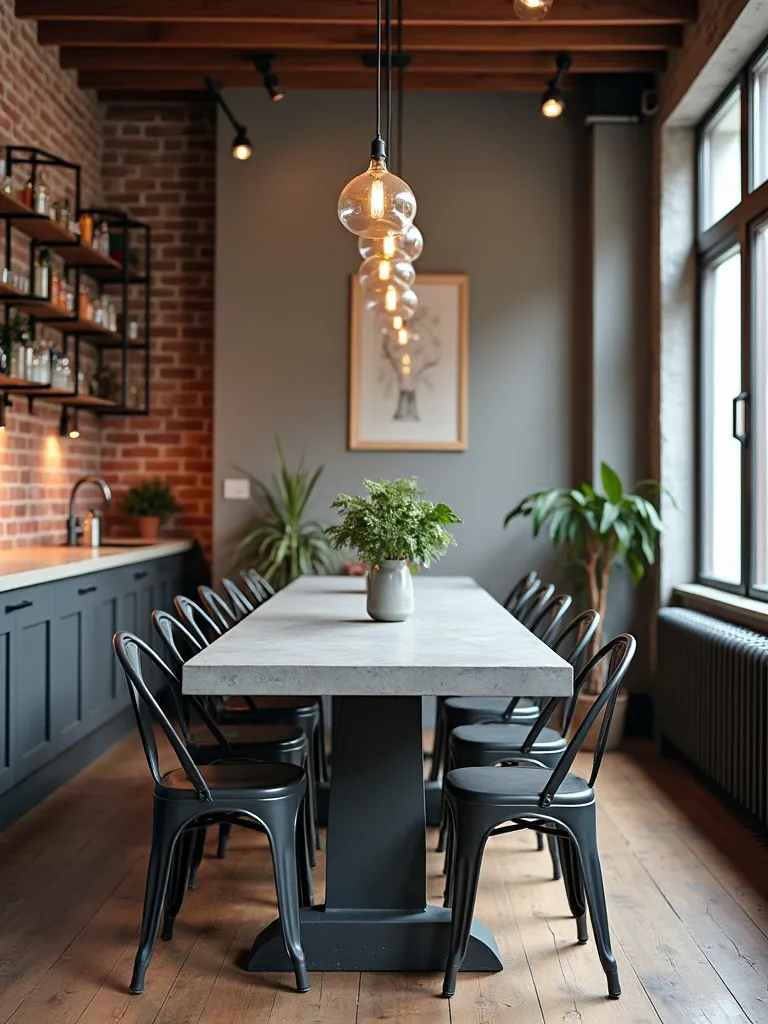
Drawbacks:
- Susceptible to scratches and moisture damage
- Requires regular maintenance to keep it looking its best
- Some types of wood may not be sustainably sourced
Pro tip: If you’re going for wood, consider bamboo or reclaimed timber. They’re eco-friendly options that pack a serious style punch!
Glass Pros and Cons
Glass tables are like the chameleons of the dining world – they can make a small space feel larger and bring a touch of modern elegance to any room. But before you get starry-eyed over that sleek glass top, let’s weigh the pros and cons.
Pros:
- Creates an illusion of more space
- Easy to clean (a quick wipe, and you’re done!)
- Versatile – pairs well with various chair styles

Cons:
- Shows fingerprints and smudges easily
- Can be fragile – not ideal for homes with young children
- May feel cold or uninviting without proper styling
I once helped a minimalist couple choose a glass-top table with a reclaimed wood base – talk about the best of both worlds!
Metal Advantages and Disadvantages
Metal tables are the superheroes of the dining world – strong, durable, and often with a cool, industrial vibe. But even superheroes have their kryptonite, so let’s break it down.
Advantages:
- Incredibly durable and long-lasting
- Resistant to scratches and dents
- Available in various finishes and styles

Disadvantages:
- Can feel cold or uninviting without proper styling
- May show rust if not properly cared for
- Can be noisy (ever tried to set down a plate on a metal surface?)
Fun fact: I once upcycled an old metal table by adding a recycled glass top – it became the talk of my client’s dinner parties!
Mixed Material Options
Now, this is where things get exciting! Mixing materials is like creating a perfect playlist – it’s all about finding the right balance and harmony. A contemporary dining room table that combines materials can be a true showstopper.
Popular combinations:
- Wood and metal: Rustic meets industrial
- Glass and wood: Airy yet warm
- Stone and wood: Earthy elegance
The key is to choose materials that complement each other and align with your overall aesthetic. I recently designed a table with a concrete top and wooden legs for a client’s urban loft – it was the perfect blend of sleek and organic.

Remember, when choosing materials for your contemporary dining room table, think beyond just looks. Consider durability, maintenance, and most importantly, how it fits into your lifestyle and values. After all, this table will be witnessing countless meals, conversations, and memories – make sure it’s up for the job!
Choosing the Right Shape
Alright, shapeshifters (pun intended), it’s time to talk about the form your contemporary dining room table will take. The shape of your table isn’t just about aesthetics – it can make or break the flow of your dining space. So, let’s explore how different shapes can transform your room and maximize your space!
Round and Oval Tables
Picture this: a lively dinner party where everyone can see each other, conversation flows as smoothly as the wine, and there’s not a sharp corner in sight. That’s the magic of round and oval tables!

Benefits of round and oval tables:
- Perfect for promoting conversation
- Great for smaller spaces – no corners means easier navigation
- Ideal for rooms with curves or unusual layouts
- Softer aesthetic – great for balancing rooms with lots of straight lines
I once helped a family of four choose a beautiful oval table made from sustainable bamboo. Not only did it fit perfectly in their cozy dining nook, but it also became the go-to spot for everything from homework sessions to game nights.
Pro tip: If you love to entertain but are tight on space, look for round tables with extendable leaves. It’s like having two tables in one!
Square and Rectangular Designs
Ah, the classics! Square and rectangular tables are the workhorses of the dining world. They’re versatile, they maximize seating, and they fit beautifully in most dining rooms.

Advantages of square and rectangular tables:
- Efficient use of space – especially rectangular tables in long, narrow rooms
- Great for large gatherings – you can always squeeze in an extra chair or two
- Versatile – works well with various contemporary chairs for your dining room
- Provides clear division of space in open-plan living areas
I recently designed a custom rectangular table for a client using reclaimed wood. We added a metal inlay down the center, creating a stunning focal point that doubled as a built-in trivet for hot dishes. Talk about form meeting function!
Table Shape for Room Size
Here’s where we put on our interior designer hats and think about space utilization. The shape of your contemporary dining room table should complement the shape and size of your room.
Guidelines for choosing the right shape:
- Square rooms: Round or square tables work well, creating a sense of balance
- Rectangular rooms: Rectangular or oval tables echo the room’s shape
- Small spaces: Round tables or drop-leaf designs can be tucked away when not in use
- Open-plan areas: Use the table shape to define the dining zone

Remember, it’s not just about the table fitting in the room – it’s about creating a comfortable flow. You should have at least 36 inches of clearance on all sides for easy movement.
I once worked with a client who had a tiny urban apartment. We chose a round pedestal table that could be pushed against the wall when not in use, instantly freeing up floor space. It was like watching a magic trick every time they transformed their living room into a dining area!
When choosing the shape of your contemporary dining room table, think about how you live and entertain. Do you host large dinner parties, or are they mostly intimate family meals? Do you need a multi-functional space for dining and working? Let your lifestyle guide your choice, and you can’t go wrong.
Remember, rules are meant to be broken (or at least bent a little). If your heart is set on a round table in a rectangular room, go for it! With the right styling and contemporary dining room lights, you can make any shape work beautifully in your space.
Selecting the Ideal Size
Alright, size enthusiasts, it’s time to break out the measuring tape and get down to business. Choosing the right size for your contemporary dining room table is like finding the perfect pair of jeans – it needs to fit just right, feel comfortable, and make you look good!

Measuring Room Dimensions
Before you fall in love with that gorgeous oversized table, let’s make sure it fits in your space. Trust me, I’ve seen too many dining room heartbreaks when people realize their dream table is too big for their room.
Steps for measuring your space:
- Measure the length and width of your dining area
- Subtract at least 36 inches from each measurement to allow for movement
- The remaining space is what you have to work with for your table
Pro tip: Use painter’s tape to mark out the table dimensions on your floor. It’s a great way to visualize how the table will fit and how much space you’ll have to move around.
I once had a client who was adamant about fitting a 10-seater table in their modest dining room. After marking out the space, they realized it would turn their dining room into an obstacle course. We ended up choosing a beautiful extendable table that could accommodate extra guests when needed without cramping their everyday style.

Seating Capacity Considerations
Now, let’s talk about how many people you want to wine and dine around your contemporary dining room table. This is where you need to balance your entertainment aspirations with the realities of your space.
General guidelines for seating capacity:
- Allow 24 inches of table edge per person for comfortable seating
- Add an extra 6 inches at each end of a rectangular table for the host and hostess
- For round tables, use this formula: Diameter (in inches) ÷ 24 = number of people who can be seated
Remember, these are just guidelines. I’ve seen cozy dinners with friends squeezed around a too-small table, and they were some of the most memorable nights. It’s all about creating the right atmosphere!
Proportional Table Sizing
Here’s where we put on our Goldilocks hat and find a table that’s not too big, not too small, but just right for your space. A well-proportioned contemporary dining room table can make your dining area feel balanced and harmonious.

Tips for proportional sizing:
- The table should be at least 36 inches away from any walls or furniture
- Leave enough room for chairs to be pulled out comfortably
- Consider the visual weight of the table – a heavy, dark table can overwhelm a small space
I once worked with a couple who had a large, open-plan living area. We chose a substantial table that could hold its own in the space, anchoring the dining area and creating a natural division from the living room. It was like watching puzzle pieces fall into place!
Remember, when it comes to selecting the ideal size for your contemporary dining room table, it’s not just about maximum capacity. Think about how you’ll use the space day-to-day. Do you need room for laptops and homework alongside dinner plates? Are you an avid board gamer who needs extra space for epic Monopoly sessions?
Your dining table is more than just a place to eat – it’s where life happens. Choose a size that supports your lifestyle, whether that’s intimate family dinners or large, lively gatherings. And hey, if you can’t decide, there’s always the option of an extendable table. It’s like having a tardis in your dining room – bigger on the inside when you need it to be!

Understanding Table Base and Legs
Alright, let’s get to the bottom of things – literally! The base and legs of your contemporary dining room table are not just about support; they’re an integral part of the design that can make or break your dining room aesthetic. So, let’s lift the tablecloth and explore what’s underneath!
Pedestal Base Features
Ah, the pedestal base – it’s like the little black dress of the table world. Sleek, versatile, and oh-so-space-saving!
Key features of pedestal bases:
- Maximizes legroom – no more playing footsie with table legs!
- Great for smaller spaces – fewer legs mean easier navigation
- Visually interesting – can be a real statement piece
- Works well with round and square tables
I once helped a young couple choose a beautiful reclaimed wood table with a central pedestal base for their tiny apartment. Not only did it save space, but the sculptural base became a conversation starter at every dinner party!

However, keep in mind that larger tables might need double pedestals for proper support. Nobody wants their dinner to end up on the floor!
Four-Legged Stability
The classic four-legged table is like that reliable friend who’s always there when you need them. Sturdy, dependable, and ready to support you through thick and thin (or in this case, heavy Thanksgiving dinners and intense board game nights).
Advantages of four-legged tables:
- Extremely stable – great for families with kids or clumsy adults (no judgment here!)
- Versatile design options – from sleek metal to chunky wood
- Easy to pair with various chair styles
- Can handle heavier tabletops like stone or thick glass
I recently designed a custom four-legged table for a client using reclaimed railroad ties. The chunky legs gave the contemporary dining room table a robust, industrial feel that perfectly complemented their loft-style apartment.

Unique Leg Designs
Now, this is where we can let our creativity shine! Unique leg designs can turn your contemporary dining room table from a mere piece of furniture into a work of art.
Some exciting leg design ideas:
- Hairpin legs for a mid-century modern vibe
- Geometric metal bases for an ultra-contemporary look
- Mixed material legs (like wood and metal) for an eclectic touch
- Angled or splayed legs for a retro feel
I once worked with an artist to create a table with legs that looked like tree branches. It was a stunning piece that brought a touch of whimsy to an otherwise modern dining room.
When choosing a base or leg design for your contemporary dining room table, consider both aesthetics and functionality. A beautiful design is great, but not if you’re constantly banging your knees on oddly placed legs!
Think about how the base complements the rest of your dining room. Is it in harmony with your contemporary dining room lights and other furniture pieces? Does it contribute to the overall style you’re aiming for?

Also, consider the material of the base about your flooring. A heavy metal base might scratch hardwood floors, while a light-colored wood might show scuffs on dark tiles. It’s all about finding that perfect balance between style and practicality.
Remember, the base of your table is its foundation. Choose wisely, and it will support not just your meals, but all the wonderful moments and memories you’ll create around your contemporary dining room table.
Final Remarks
Whew! We’ve been on quite a journey, haven’t we? From exploring sustainable materials to pondering over shapes and sizes, we’ve covered all the bases (pun intended!) when it comes to choosing the perfect contemporary dining room table.
Remember, your dining table is more than just a piece of furniture – it’s the heart of your home, a gathering place for good food, great conversations, and lasting memories. It’s where you’ll share meals with loved ones, host game nights with friends, and maybe even burn the midnight oil on work projects (we’ve all been there!).
When making your final decision, consider these key points:
- Choose materials that align with your values and lifestyle
- Select a shape that complements your room and enhances the flow
- Opt for a size that fits your space comfortably and meets your seating needs
- Pick a base design that balances aesthetics with functionality
- Ensure your table harmonizes with your overall contemporary dining room design
But here’s the most important thing to remember: trust your instincts! You know your space and your needs better than anyone else. If you fall in love with a table that breaks all the “rules” but feels right for you, go for it! Some of the most stunning dining rooms I’ve designed have been born from thinking outside the box.
I remember working with a client who insisted on a massive, reclaimed wood table for their modest dining room. On paper, it shouldn’t have worked – but when we brought it in, it transformed the space into a cozy, inviting nook that became the family’s favorite spot. It just goes to show that sometimes, the heart knows best!


